Scroll to:
METHODOLOGY FOR EVALUATING THE STRATEGY AND PROGRESS OF INSTITUTIONAL TRANSFORMATIONS OF INDUSTRIAL COMPLEXES IN THE DIGITAL ECONOMY
https://doi.org/10.17747/2618-947X-2020-3-250-261
Abstract
The article is devoted to topical issues of transformation and development of Russian industry. The purpose of the research is to develop and test a methodology for evaluating the strategy and progress of institutional transformations of industrial complexes in the digital economy. The article defines the content of the methodology as a sequence of analytical stages that allow us to give a multidimensional and integrated assessment of strategic, process, structural, functional, technological, innovative, digital, institutional and other key aspects of the transformation of industrial complexes. The novelty and distinctive feature of the method are the ability to analyze the efficiency, speed, scale and resource support of institutional transformations of various types of industrial complexes in comparison with the average values of indicators for the Russian industry. Testing of the method was carried out on the production complex of Russia as a whole, as well as four industry, five territorial and fifteen local complexes. It is determined that transformations in the domestic industry are local, reactive and low-dynamic. Reengineering of functions, business processes, organizational structures, institutions and management systems of enterprises is carried out at an insufficient pace. Most Russian companies have not changed their strategies in the context of the digital economy. A list of ways to improve the efficiency of transformation of domestic enterprises is proposed.
Keywords
For citations:
Boev A.G. METHODOLOGY FOR EVALUATING THE STRATEGY AND PROGRESS OF INSTITUTIONAL TRANSFORMATIONS OF INDUSTRIAL COMPLEXES IN THE DIGITAL ECONOMY. Strategic decisions and risk management. 2020;11(3):250-261. https://doi.org/10.17747/2618-947X-2020-3-250-261
1. INTRODUCTION
Dynamic formation of digital economy and active shaping of the new model of economic management determine the relevance of the conduct of institutional transformations in Russian industry [Benner, Tushman, 2003; Kirchgässner et al., 2013; Karlik et al., 2019; Kvint, 2020].
A very important task of the scientific community is theoretical and methodological support of the started reforms in the industrial sector of the country, as well as creation of tools for their comprehensive analyses [Antipin, 2019].
A significant contribution to the research of the problems of evolution, transformations and changes of economic systems, enterprises and complexes was introduced by T. Veblen, D. Nort, Y. Aruka, K. Torli, H. Wirndenius, E. Deming, J. Hodgson, K. Yagi, J. Shumpeter, U. Schukhart, F. Kotler, B. Kleiner, V. Quint, A. Karlik, K. Levin, L. Gitelman, Yu. Anisimov, V. Polterovich and others. Today, the dominant part of the named scientists’ developments retains its relevance and practical value, but the phenomena generated by the digital environment and the features of economic relations require further scientific knowledge development and continuous formation of new competencies to effectively manage the transformation of industrial companies.
At present, a rather acute problem of the digital economy formation is the lack of methodological tools to identify, analyze and purposefully design systemic changes in industry, taking into account the exponential development of information and communication technologies and digital innovation.
As part of the solution of this problem, the author has developed a methodology for evaluating the strategy and progress of institutional transformations of industrial complexes in the digital economy.
2. METHODOLOGY FOR EVALUATING THE STRATEGY AND PROGRESS OF TRANSFORMATIONS
In its content the methodology is an algorithm of analytical actions. The implementation of such an algorithm allows to give a multidimensional integrated evaluation of the strategy, process, results, scale, speed, efficiency and sustainability of transformations, as well as the aspects of innovation, digital, structural, functional, technological, institutional and infrastructure transformations of industrial, territorial and local industrial complexes in comparison with the average values of indicators for Russian industry. The advantage of the methodology is the ability to determine the type of transformation (leading or lagging) taking place in manufacturing enterprises.
The purpose of the methodology is to investigate the state of the strategy and process of transformations of industrial structures in the digital economy. Objectives of the methodology: (1) to analyze the current transformation level of the different types of industrial complexes in the digital environment; (2) to identify the positive and negative aspects of the strategy and process of institutional changes of industrial complexes and enterprises; (3) to determine the prospects and actual directions of institutional transformations in industry.
The object of the study is industrial complexes of macro-, meso-, and microlevels, which include: (1) the industrial complex of Russia as a whole; (2) sectoral industrial complexes engaged in the kinds of activity B (extraction of minerals), C (manufacturing), D (provision of electric power) and E (water supply; waterdisposal) according to OKVED; (3) the territorial industrial complexes of Belgorod, Voronezh, Kursk, Lipetsk and Tambov regions; (4) the local industrial complexes of different regions of Russia - JSC “Concern Sozvezdie”, JSC “Borkhimmash”, LLC FPC “Cosmos-Neft-Gas”, JSC “PK Energia”, CJSC “PPK Ural”, JSC “NPKDAR Research Institute of Long-Distance Radio Communications”, JSC “SPA Gidromash” and others.
Tools of methodology - statistical research methods (analysis of dynamic series, comparative and regression analysis, normalization, indexing), expert research methods (method of expert evaluations, coefficient method), methods of structural and functional analysis, monitoring, forecasting, analytical visualization, formation of databases.
The information base of the study is the data of Rosstat, financial statements of enterprises, databases of economic indicators ("SPARK-Interfax"), documents of regional development of Belgorod, Voronezh, Kursk, Lipetsk and Tambov regions.
The algorithm of the methodology is presented in Fig. 1. It includes six main stages. The successive performance of these stages provides a comprehensive evaluation of the strategies and progress of institutional transformations of the different types of industrial complexes in comparison with the average indicators for Russian industry. Thus, the methodology makes it possible to diagnose not only the state of the strategy and process of transformation of enterprises, but also to identify the nature of changes (leading or lagging) implemented by them.
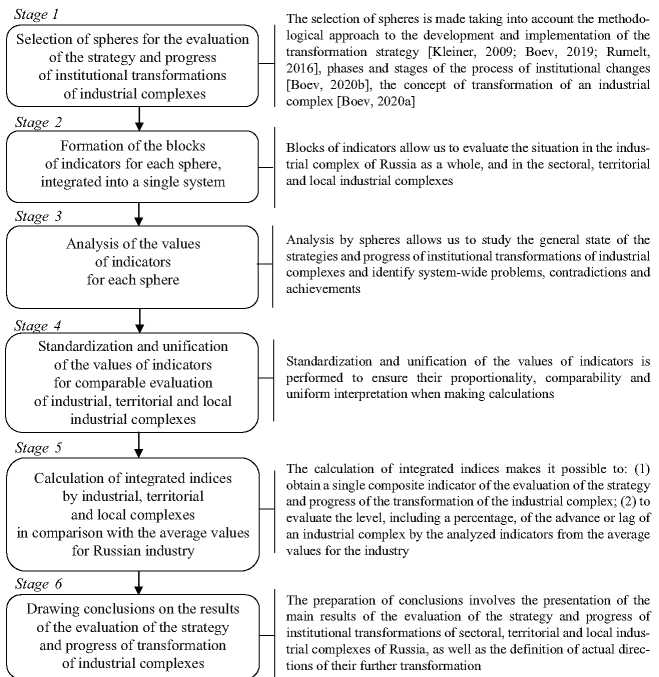
As part of the implementation of the first and second stages of the methodology, a system of 75 indicators, combined into 14 blocks (Table 1) was developed. This system of indicators meets the following important requirements and criteria:
- it takes into account the logical connection and interdependence between the transformations and development of industrial complexes [Boev, 2020a];
- it is balanced and consistent; makes it possible to study all the main spheres of functioning, transformation and development of industrial complexes [Cotton, 2008; Vizgunov, 2013; Yendovitsky, 2017];
- it allows us to study the strategies and progress of transformations in industrial complexes, selected by sectoral, territorial and other characteristics;
- it contains indicators refl ecting the key phases and stages of the process of institutional transformation of industrial complexes in the digital economy (for example, updating the strategic course, transforming institutions, adjusting functions and processes, implementing digital transformation, etc.) [Boev, 2020b].
Table 1
The system of the indicators of evaluation of the strategy and progress of institutional transformations of industrial complexes
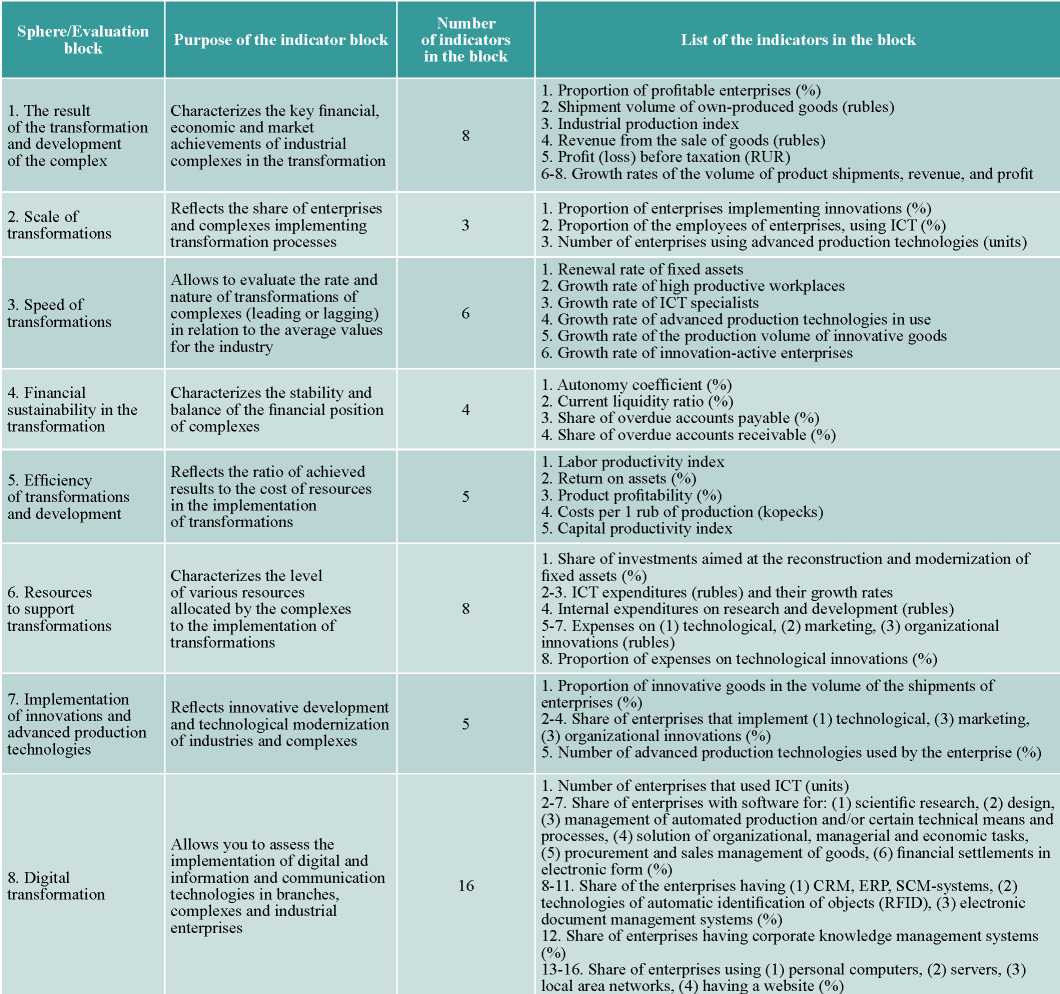
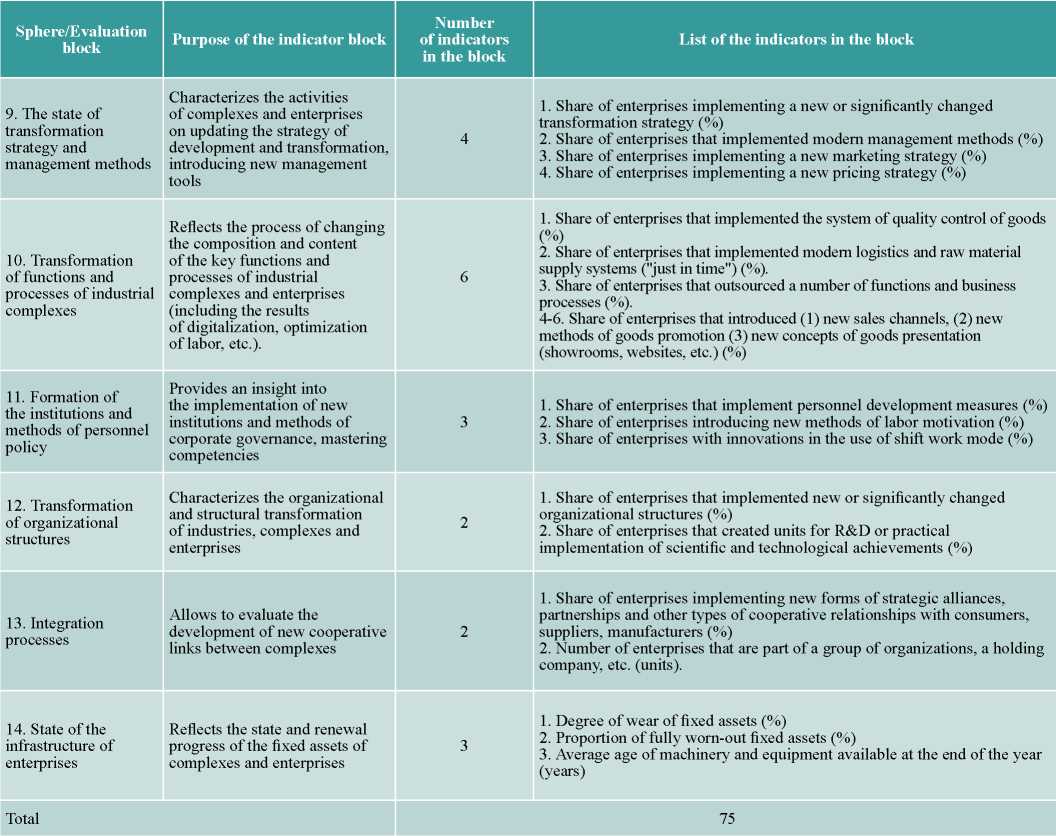
3. APPROBATION OF THE PROPOSED METHODOLOGY
In accordance with the presented system of indicators a study of the strategy and progress of institutional transformations in the industrial complex of the Russian Federation was carried out (the data on the key blocks of indicators are presented).
In 2014-2018, the financial results of Russia's industrial complex have a stable and positive dynamics (Table 2).
Table 2
Indicators of the result of transformations and development of the industrial complex in Russia
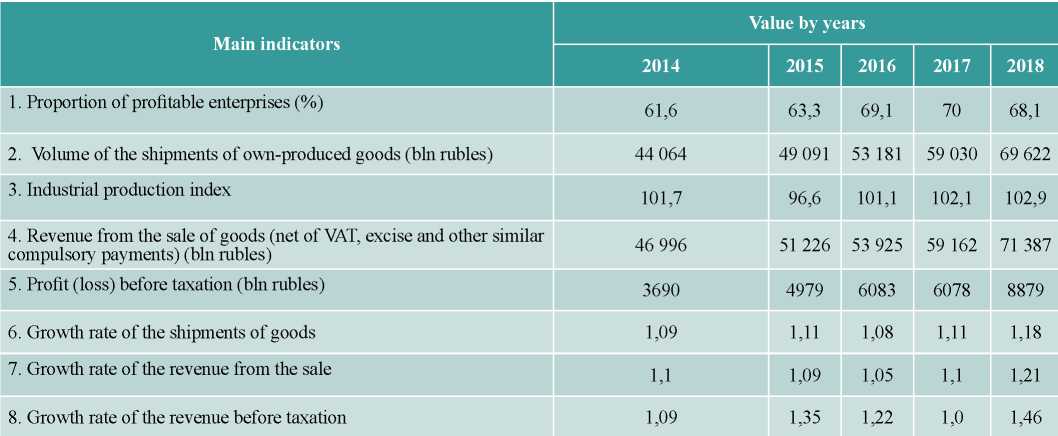
Source: Federal State Statistics Service. URL: http://www.gks.ru/.
At certain time intervals, the growth rates of the volume of product shipments, revenues, and profits significantly outstrip the production index. This disproportion is due to the fact that an important factor in increasing the fi nancial indicators of enterprises is not so much the development of their own production as infl ationary growth, the realization of the reserves of finished products, currency and price fl uctuations, and structural changes in industries.
The current scale of transformations taking place in the industry is insufficient, and the dynamics of its expansion is low. For example, during five years the number of enterprises using advanced technologies has grown by only 1,337 units, which is about 0.3-0.5% of the total number of industry entities.
The rate of transformations of the industrial complex of the Russian Federation is unstable and unsteady. For example, the average annual value of the fixed asset renewal indicator is only 6.2%. It is low and does not ensure the recovery and development of production assets in Russia. Thus, the degree of wear of funds of domestic production companies increased from 43.6% to 50.8% over 2010-2018.
Analyzing the efficiency of transformations in the industrial sector of Russia, it is advisable to consider the state of the labor productivity indicator. For 2014-2018, its growth was only 4.3%, which does not allow Russia to approach the values of the developed economies of the world, especially in high-tech industries.
The study of the indicators of introduction of innovations and advanced production technologies shows that complexes and enterprises in Russia are characterized by a systematically low level of innovation activity (Table 3).
Table 3
Indicators of the implementation of innovation and advanced production technologies in the Russian industrial complex
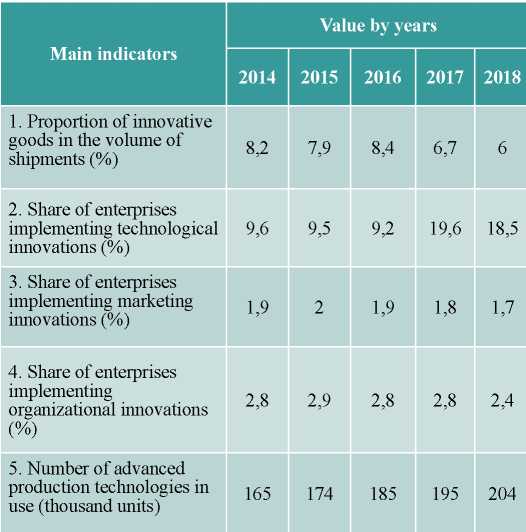
Source: Federal State Statistics Service. URL: http://www.gks.ru/.
Over 2014-2018, some of the key indicators of innovative activity of domestic manufacturing companies decreased. The proportion of innovative products in the volume of shipments decreased by 2.2 items, from 8.2 to 6%. The share of enterprises that implemented marketing and organizational innovations decreased by 0.2-0.4 items to 1.7% and 2.4%, respectively.
At present, the domestic industry is completing the process of basic informatization. More than 90% of enterprises use personal computers and information and communication technologies (ICT); 78.6% of companies have electronic document management systems, 72% have programs for financial mutual settlements in electronic form, 70% have introduced specialized software for organizational, managerial and economic tasks (Table 4).
Table 4
Indicators of digital transformation of the industrial complex in Russia (excerpt)
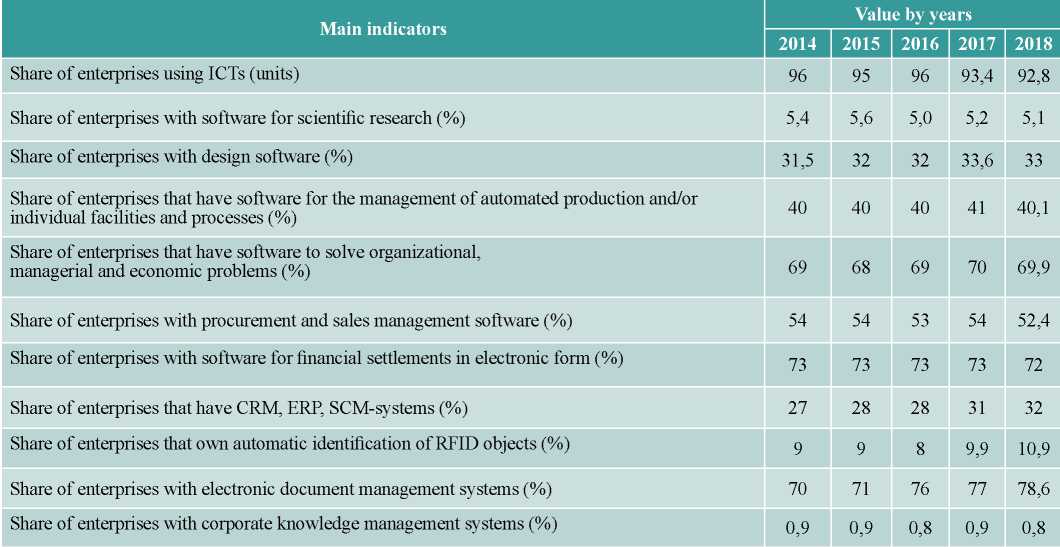
Source: Federal State Statistics Service. URL: http://www.gks.ru/.
Digital transformation of industrial complexes is not identical to informatization activities. It involves the integration of key business processes of an enterprise on a single digital platform and is distinguished by the use of intelligent software capable of supporting non-standard functions, management decisions and interstructural operations [Karlik et al., 2019]. Due to its complexity, the process of digital transformation of production complexes is slower than informatization processes. For example, the share of enterprises with technological CRM, ERP, SCM systems is only 32%.
A study of the strategic aspects of industry transformation in Russia (Table 5) shows that in 2014-2018, only 1% of companies developed and implemented a new development and transformation strategy to adapt to the digital economy.
Table 5
Indicators of evaluating the strategy for transforming the industrial complex in Russia
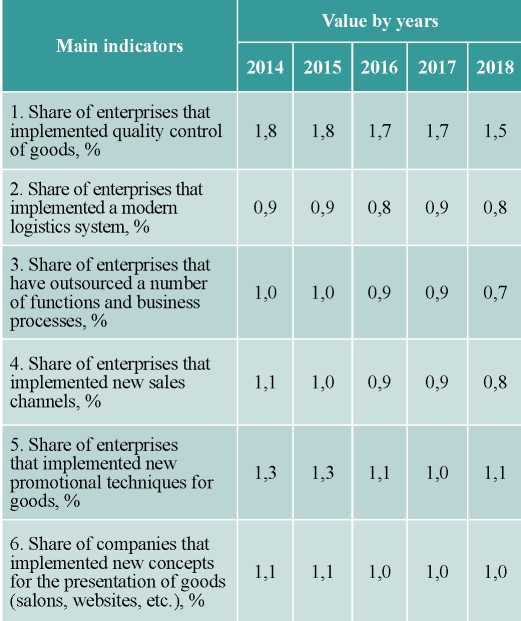
Source: Federal State Statistics Service. URL: http://www.gks.ru/.
The market behavior of enterprises has not changed fundamentally. Only 1.1% of companies have developed a new marketing strategy and 0.8% - a pricing one. The share of enterprises that have implemented modern management methods is only 1.4%. For all of the considered indicators there is negative dynamics, which indicates the lack of conscious and purposefully formed strategy of business transformation in the management of production complexes in the conditions of changing market relations and the emergence of digital economy.
There is a low level and dynamics of the transformation of functions and business processes in the country's industry (Table 6). The share of enterprises that have implemented a modern logistics system, use outsourcing, apply new sales channels, etc., does not exceed 1.5%.
Table 6
Indicators for evaluating the transformation of functions and business processes of the industrial complex in Russia
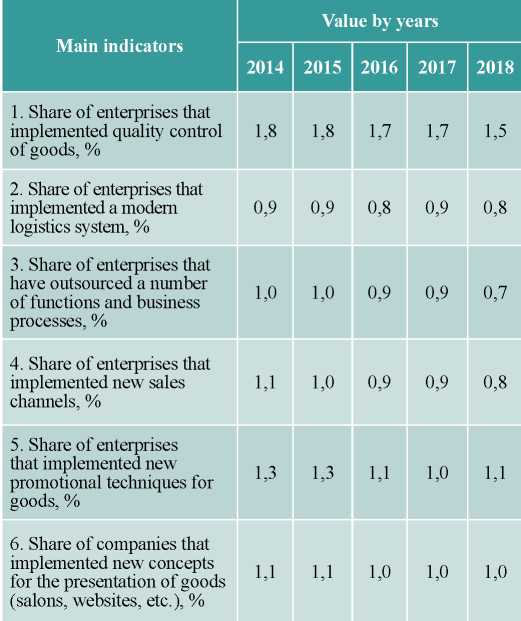
Source: Federal State Statistics Service. URL: http://www.gks.ru/.
The share of enterprises forming new institutions and realizing a modern personnel policy remains quite low, in the range of 0.5-2% (Table 7). This problem is crucial for the development of the real sector of the economy, as it does not allow the personnel to be systematically involved in the issues of production transformation and to make them a "carrier" of institutional changes and transformations.
Table 7
Indicators for evaluating the formation of the institutions and new personnel policy of the industrial complex in Russia
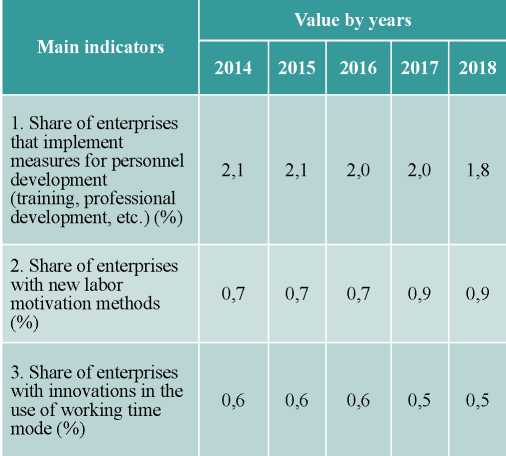
Source: Federal State Statistics Service. URL: http://www.gks.ru/.
The task of forming a new institutional support and staffing of industry is relevant not only for Russia, but also for the leading economies of the world. For example, in 2019 about 180 of the largest companies in the U.S. (Boeing, General
Motors, Exxon Mobil, Apple, AT&T, Coca-Cola, Comcast, Ford, Johnson&Johnson, Lockheed Martin and others) approved an updated corporate purpose statement. It calls for not treating profit maximization as the top priority of corporations’ operations and invites investors to support manufacturers investing resources in their workforce. In particular, JP Morgan Chase CEO J. Dimon noted that “major employers are investing in their workers and communities because they know it is the only way to be successful over the long term”1.
The process of structural transformation of the domestic industry is slowing down (Table 8). The share of enterprises that developed and implemented new organizational structures in 2014-2018 is at the level of 1.2-1.5% with a declining trend. The share of enterprises that created specialized R&D units decreased to 0.3% during five years, indicating a slowdown in the development of on-site corporate science.
Table 8
Indicators for evaluating the transformation of the organizational structures of the industrial complex in Russia
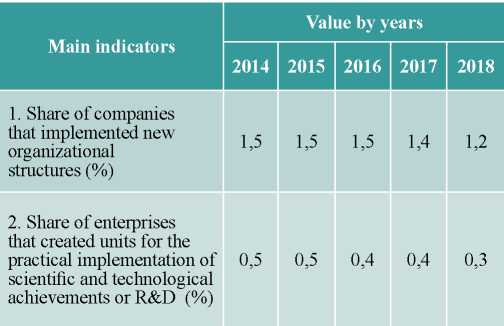
Source: Federal State Statistics Service. URL: http://www.gks.ru/.
Between 2014 and 2018, the number of enterprises that are part of a group of companies increased by 1,864 and reached 7,285. The overall level of the sector integration increased from 12 to 19%, but this is associated not only with the cooperation development in industry, but also with a sharp decrease in the total number of manufacturing enterprises in Russia (that is, the base from which the indicator is calculated; the decrease is about 78 thousand units for five years).
4. CALCULATION SECTION
In order to provide a comparable assessment of sectoral, territorial and local industrial complexes in comparison with the average values for the Russian industry, the standardization and unification of the analyzed indicators were carried out, as well as the calculation of integrated assessment indices was made. The relevance and expediency of the use of integrated indices in the multidimensional assessment of economic phenomena and processes are noted by many researchers [Voroshylov and Gubanova, 2013; Shkarupeta et al., 2016; Khabriev et al., 2020]. In particular, N.M. Abdikeyev, Director of the Institute of Industrial Policy and Institutional Development of the Financial University by the Government of the Russian Federation, expresses the idea that "for the effective operational use of the system of indicators... especially the complex architecture, it seems effective to compile summary indicators in the form of an appropriate index..." [Abdikeyev, Moreva, 2019].
The calculation of the index for each of the 75 indicators, included in the assessment system for 2014-2018, is carried out as the ratio of the value of each indicator for the sectoral, territorial or local complex to the corresponding average value of the indicator for the industry as a whole.
To form aggregate indices by the blocks for evaluating the strategy and progress of institutional transformations of the sectoral complexes, let us write down:
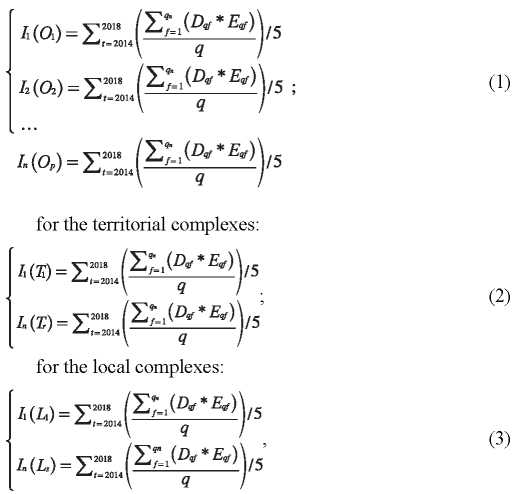
where, n – the number of blocks in the system of indicators to evaluate the strategy and progress of institutional transformations (14 units);
I – an aggregate index for the n-th block of indicators
q – the number of indicators in the n-th block;
t – the duration of the analyzed period - 2014-2018 (five years);
D –the index of the f-th indicator in the n-th block;
E – the value of the weighting coefficient to the f-th indicator;
O, T, L – a kind of the sectoral, territorial or local complex;
p, r, s – the number of analyzed sectoral, territorial and local industrial complexes, respectively.
To calculate the integrated indices by the sectoral complexes, write:
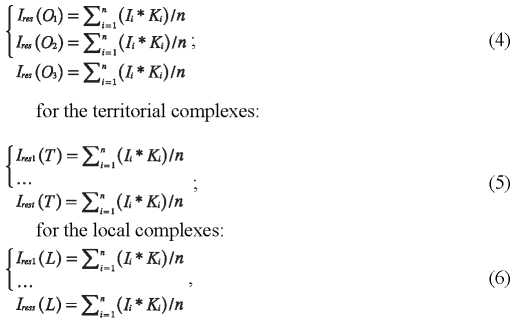
where Ires (O, T, L) – an integrated evaluation index of the corresponding type of industrial complex for all blocks of indicators;
K – the correction factor applied to the corresponding block of indicators in the integrated index calculation.
The indices of the blocks of indicators and the integrated index, refl ecting average values for the industry as a whole (P), are taken equal to one. Accordingly, the nature of the progress of transformations of sectoral, territorial and local complexes is determined depending on the following conditions (Table 9).
Table 9
Conditions for evaluating the nature of the transformation progress of the industrial complex in Russia
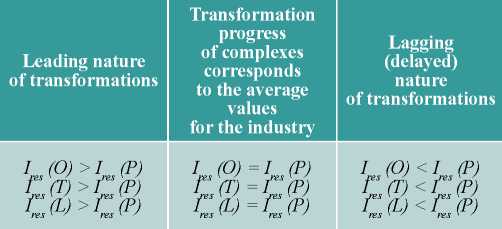
The difference between the indices Ires (P) and Ires (O, T, L) shows the value (share) by which sectoral, territorial and local complexes are ahead (or behind) in evaluating the strategy and progress of institutional transformations from the average values for the industry. The difference between the indices Ires (O), Ires(T) and Ires (L) characterizes the value by which one kind of industrial complex is ahead of another kind by the indicator of integrated assessment.
5. RESULTS AND CONCLUSIONS
The calculated values of the aggregate and integrated indices for evaluating the strategy and progress of institutional transformations of industrial complexes for 2014-2018 are presented in Table 10.
Table 10
Consolidated indices for evaluating the strategy and progress of institutional transformations of industrial complexes in the digital economy for 2014-2018
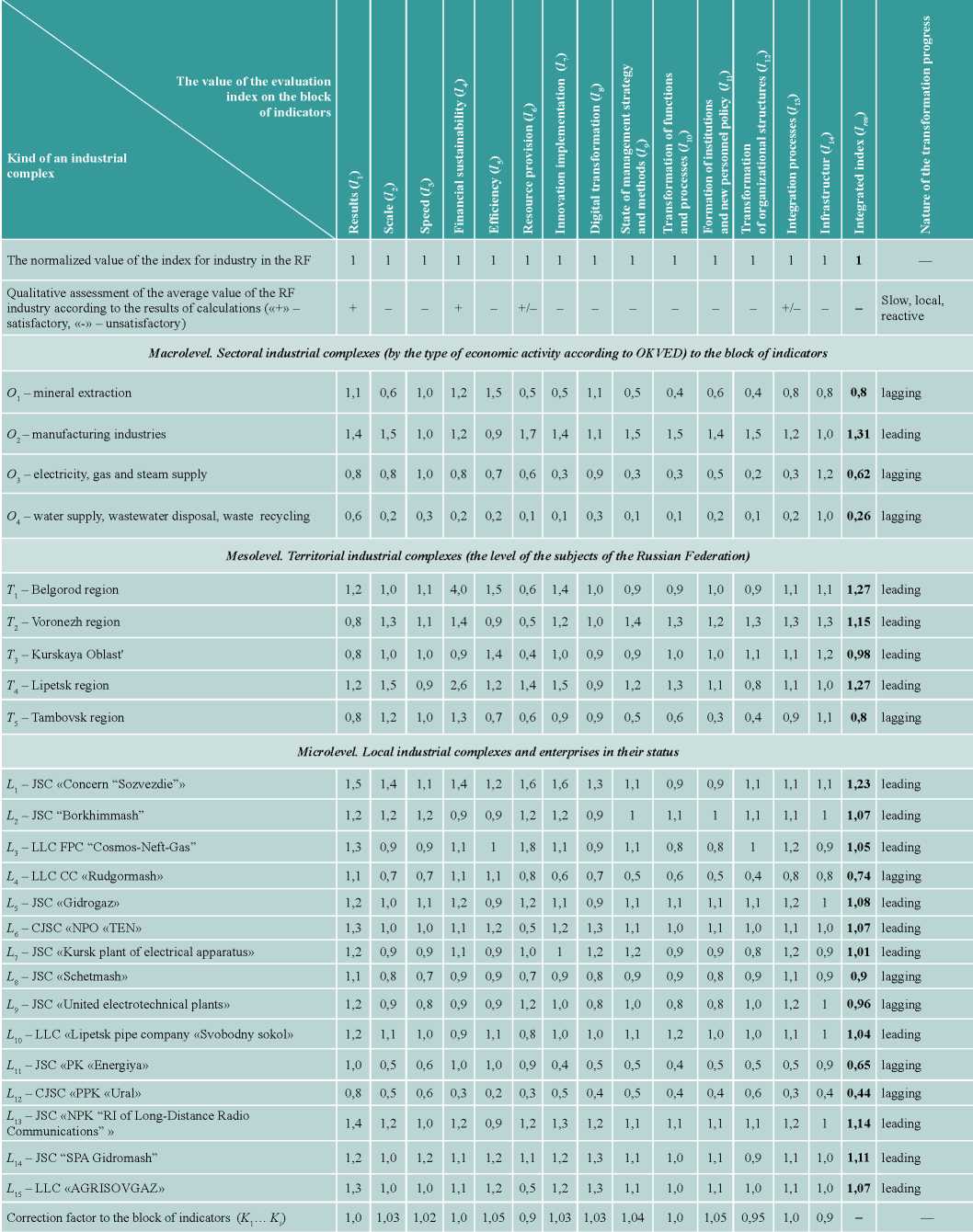
The following conclusions can be made based on the results of the analysis.
1. The current development and transformation of Russia's industrial complex is carried out mainly according to the inertial scenario. The dominant factor in the growth of the fi nancial indicators of enterprises is not so much internal transformations as infl ation and changes in external market conditions.
2. In 2014-2018, the vast majority of manufacturing enterprises (about 99%) in Russia have not fundamentally changed their development and transformation strategies in the context of the digital economy formation and the aggravation of crisis trends.
3. By their kind, institutional transformations taking place in the country's industrial complex are low-dynamic, local, reactive and predominantly exogenous (caused by external factors).
4. Transformation of functions, business processes, organizational structures, institutions, management systems and corporate culture in the domestic industry is carried out at an insuffi cient pace.
5. The digital transformation of Russia's industrial complex is uneven. Most enterprises have "digitized" only simple, routine and local operations (financial, logistics, etc.), while complex interdepartmental functions and business processes (knowledge management, performing scientific research, etc.) remain at the initial level of automation and digitalization.
6. For a long time two systemic problems remain in the country's industry - low labor productivity and unstable innovative activity of enterprises. They are a consequence of the use of outdated technology and high wear on equipment, ineffi cient management models and organization of business processes, as well as the presence of other accumulated contradictions and imbalances. The solution of these problems is not possible within the framework of individual tactical measures, requires a comprehensive approach and confirms the relevance and necessity of deep institutional reforms in Russian production [Forecasting efficiency…, 2008; Chen, Adamson, 2015].
7. The composite index of the evaluation of the strategy and progress of institutional transformations in the manufacturing complex is 1.31 and exceeds the average value for the industry by 0.31 (or 31%). The transformation of the manufacturing complex in most spheres is ahead of other key industries, but inferior to the mining complex in terms of efficiency.
8. In Russia's mining complex, the ongoing transformations are not large-scale; the transformation indexes of functions, processes, structures and institutions are 40-60% lower than the industry average. At the same time, the performance, fi nancial sustainability and efficiency of the development and functioning of extractive companies are quite high. For example, for 2014-2018, the average annual ratio of profit and revenue (return on sales) in the mining complex reached the value of 20% (in some years - more than 30%), while for industry as a whole it was only 12-13%, and in the manufacturing sector - 9-10%. The high financial performance of extractive companies with the lagging nature of ongoing transformations is largely due to the oligopolistic model of competition in the mining markets and high entry barriers that protect incumbent producers from the pressure of new players.
9. The values of the composite indices for evaluating the strategy and progress of transformations of the sectoral complexes specializing in the provision of electricity, gas and steam (the kind of economic activity D), as well as water supply, water disposal and waste recycling (the kind of economic activity E), are below the average values for industry by 30 and 70%, respectively. This testifies to the slow (lagging) character of development and transformation of the specified segment of enterprises. At the same time, the composite assessment indices for these industries have grown markedly over five years: for economic activity D - from 0.59 in 2014 to 0.67 in 2018; for activity E - from 0.25 to 0.56.
10. The analysis of territorial industrial complexes shows that the highest indices for evaluating the strategy and transformation progress are observed in Belgorod (1.27), Lipetsk (1.27) and Voronezh (1.15) regions. The production enterprises of these regions are transforming with a noticeable advance in relation to the average Russian values. They are characterized by high innovation activity, financial stability, work on the optimization of strategies, functions and business processes. The industrial complex of the Tambov region can be noted among the "laggards" (index value - 0.8).
11. The conducted calculations show that the main part of the investigated local industrial complexes (for example, JSC “Concern Sozvezdie”, JSC “Borkhimmash”, JSC “Gidrogaz”, LLC FPC “Cosmos-Neft-Gas”, JSC “NPK RI of Radio Communications”, etc.) is transformed at a faster rate than the market. On the one hand, this is due to the fact that most of the enterprises under consideration are system-forming companies in their regions, they are residents of various clusters, integrated into federal and interregional value chains, implement strategies of long-term changes, have R&D units and carry out innovative projects. On the other hand, they receive systemic support in the form of state orders, which largely determines their financial sustainability.
It should be noted that the named companies operate in hightech markets and, despite the current relatively stable situation, should intensify work to optimize the strategy and process of transformations in order to remain competitive.
12. LLC CC “Rudgormash”, JSC “Schetmash”, JSC “United Electrotechnical Plants”, JSC “PK Energia” and CJSC “PPK Ural” are slightly behind the average values for the industry by the integrated index for evaluating the strategy and progress of transformations. The most difficult situation is observed at CJSC “PPK Ural” - the enterprise is in a pre-bankruptcy state.
6. CONCLUSION
The low quality, insufficient efficiency and general lack of focus of the ongoing shifts in Russia's economy create significant limitations and risks for the development of various sectors of the country [Sukharev, 2013]. The continued use of irrelevant strategies and outdated business models by the majority of industrial complexes in the emerging digital world will lead to strengthening the accumulated problems and contradictions in domestic production, as well as a decrease in the competitiveness of industrial Russian companies.
According to the author, the important directions of improving the efficiency of institutional transformations of industrial complexes in Russia should be:
- Development and implementation of relevant strategies at enterprises, which are aimed at reforms and adaptation of companies to the new realities of the digital economy [Kalashnikov, 2016];
- Formation of real motivational and financial mechanisms for enterprises, stimulating their transformation and technological modernization;
- Acceleration of the pace of innovation activity and digital transformation of industrial complexes, including through in-depth cooperation and integration with scientific, research, expert and educational organizations.
The list of proposed directions is not exhaustive, but it is able to intensify the process of institutional changes in the industrial complex of the country and gradually form an actual model of its functioning, corresponding to the new economic order [Kalashnikov, 2016].
1. Statement on the purpose of a corporation. URL: https://opportunity.businessroundtable.org/ourcommitment/.
References
1. Abdikeev N.M., Moreva E.L. (2019). Monitoring innovatsiy v razvitykh ekonomikakh: sistemy pokazateley i ikh ispol’zovanie v Rossii [The innovations’ monitoring in the developed economies: The systems of indicators and their application in Russia] Strategicheskie resheniya i risk-menedzhment [Strategic Decisions and Risk Management], 10(3), 202-209.
2. Antipin I.A. (2019). Ob otsenke strategiy sotsial’no-ekonomicheskogo razvitiya krupneyshikh gorodov Urala [On the assessment strategies of socio-economic development the largest cities of the Urals]. Vestnik ekonomiki, prava i sotsiologii [Bulletin of Economics, Law and Sociology], 3, 13-17.
3. Boev A.G. (2019). Metodologicheskiy podkhod k razrabotke i realizatsii strategii institutsional’nykh preobrazovaniy promyshlennogo kompleksa [Methodological approach to the development and implementation of strategy for institutional change industrial complex]. Izvestiya DVFU. Ekonomika i upravlenie [Proceedings of the University. Economics and Management], 4, 69-81.
4. Boev A.G. (2020a). Kontseptsiya institutsional’nykh preobrazovaniy promyshlennykh kompleksov v usloviyakh tsifrovoy ekonomiki [The concept of institutional restructuring of industrial complexes in conditions of digital economy]. Vestnik Rossiyskogo ekonomicheskogo universiteta im. G.V. Plekhanova [Vestnik of the Plekhanov Russian University of Economics], 1(1), 108-121.
5. Boev A.G. (2020b). Soderzhanie i osobennosti protsessa institutsional’nykh preobrazovaniy promyshlennykh kompleksov v usloviyakh tsifrovoy ekonomiki [The contents and peculiarities of the process of institutional transformation of industrial complexes in a digital economy]. Ekonomika v promyshlennosti [Russian Journal of Industrial Economics], 13(1), 18-28.
6. Vizgunov A.N. (2013). Klyuchevye kharakteristiki preobrazovaniya biznes-protsessov predpriyatiya [Key characteristics of the enterprise business process redesign]. Vestnik Nizhegorodskogo universiteta im.
7. N.I. Lobachevskogo [Vestnik of the Lobachevsky University of Nizhny Novgorod], 2(1), 224-229.
8. Voroshilov N.V., Gubanova E.S. (2013). Otsenka urovnya sotsial’no-ekonomicheskogo razvitiya regionov Rossii [Assessment of the level of socio-economic development of Russian regions]. Ekonomika i predprinimatel’stvo [Economics and Entrepreneurship], 12(3), 325-332.
9. Endovitsky D.A. (2017). Kompleksnyy analiz i kontrol’ investitsionnoy deyatel’nosti [Complex analysis and control of investment activity]. Moscow, Finansy i statistika.
10. Kalashnikov S.V. (2016). Upravlenie strukturoy modernizatsii Rossii [Managing the structure of Russian modernization]. Nauchnye trudy Vol’nogo ekonomicheskogo obshchestva Rossii [Scientific Works of the Free Economic Society of Russia], 197, 80-85.
11. Karlik A.E., Platonov V.V., Krechko S.A. (2019). Organizatsionnoe obespechenie tsifrovoy transformatsii kooperatsionnykh setey i vnedreniya kibersotsial’nykh sistem [Organizational support for the digital transformation of cooperation networks and the implementation of cyber-social systems]. Nauchno-tekhnicheskie vedomosti SPbGPU. Ekonomicheskie nauki [St. Petersburg State Polytechnical University Journal. Economics], 12(5), 9-22. DOI: 10.18721/JE.12501.
12. Quint V. L. (2020). Kontseptsiya strategirovaniya [The concept of strategizing: A monograph]. Kemerovo, Kemerovo State University.
13. Kleiner G.B. (2009). Sistemnyy podkhod k strategii predpriyatiya [A systemic approach towards a business strategy]. Sovremennaya konkurentsiya [Modern Сompetition], 1, 100-118.
14. Prognozirovanie effektivnosti sotsial’no-ekonomicheskikh preobrazovaniy v territorial’nykh sistemakh [Forecasting the effectiveness of socio-economic transformations in territorial systems] (2008). Ekaterinburg, Institute of Economics of the Ural Branch of the Russian Academy of Sciences.
15. Sukharev O.S. (2013). Adekvatnost’ strategii operezhayushchego razvitiya ekonomiki Rossii v global’nykh izmeneniyakh [Adequacy of the strategy of advanced development of the Russian economy in global changes]. Strategiya ekonomicheskogo razvitiya (Ekonomicheskiy analiz: teoriya i praktika) [Strategy of Economic Development (Economic Analysis: Theory and Practice)], 47(350), 2-15.
16. Khabriev B.R., Bakhtizina N.V., Bakhtizin A.R. (2020). Podkhod k integral’noy otsenke rezul’tativnosti strategii razvitiya neftyanoy otrasli Rossii [Approach to an integrated assessment of the effectiveness of the development strategy of the Russian oil industry]. Ekonomika v promyshlennosti [Russian Journal of Industrial Economics], 13(1), 123-131.
17. Shkarupeta E.V., Krasnikova A.V., Shishkin I.A. (2016). Verifikatsiya metodiki otsenki investitsionnoy privlekatel'nosti proekta vnedreniya IT na vysokotekhnologichnom naukoemkom predpriyatii [Verification of a investment appeal assessment technique of the IT introduction project at the hi-tech knowledge-intensive enterprise]. Vestnik Voronezhskogo gosudarstvennogo universiteta inzhenernykh tekhnologiy [Proceedings of the Voronezh State University of Engineering Technologies], 2, 384-388.
18. Benner M., Tushman M. (2003). Exploitation, exploration, and process management: The productivity dilemma revisited. The Academy of Management Review, 28(2), 238-256.
19. Chen J., Adamson C. (2015). Innovation: Integration of random variation and creative synthesis. Academy of Management Review, 40(3), 461-464.
20. Cotton D. (2008). Keys to management. Harlow, Longman.
21. Kirchgässner G., Wolters J., Hassler U. (2013). Introduction to modern time series analysis. New York, Springer.
22. Rumelt R.P. (2016). Good Strategy / Bad Strategy. New York, Crown Business.
About the Author
A. G. BoevRussian Federation
Candidate of economic sciences, deputy head of an autonomous institution of the Voronezh Region «Analytical Center for the Government of the Voronezh Region». Research interests: strategic management, analytical activities, digital economy, institutional transformation in industry.
Review
For citations:
Boev A.G. METHODOLOGY FOR EVALUATING THE STRATEGY AND PROGRESS OF INSTITUTIONAL TRANSFORMATIONS OF INDUSTRIAL COMPLEXES IN THE DIGITAL ECONOMY. Strategic decisions and risk management. 2020;11(3):250-261. https://doi.org/10.17747/2618-947X-2020-3-250-261









































